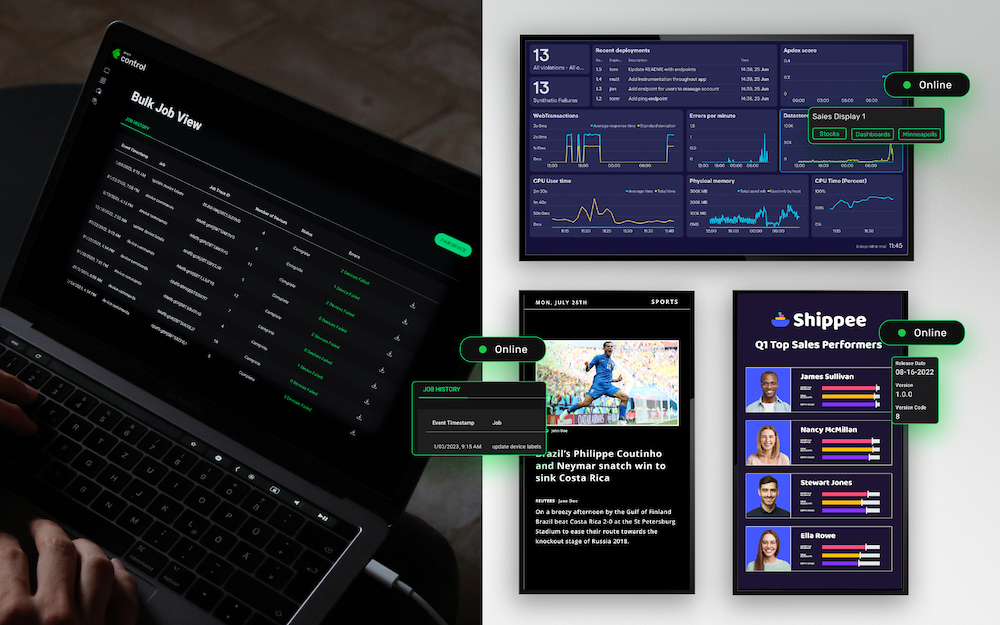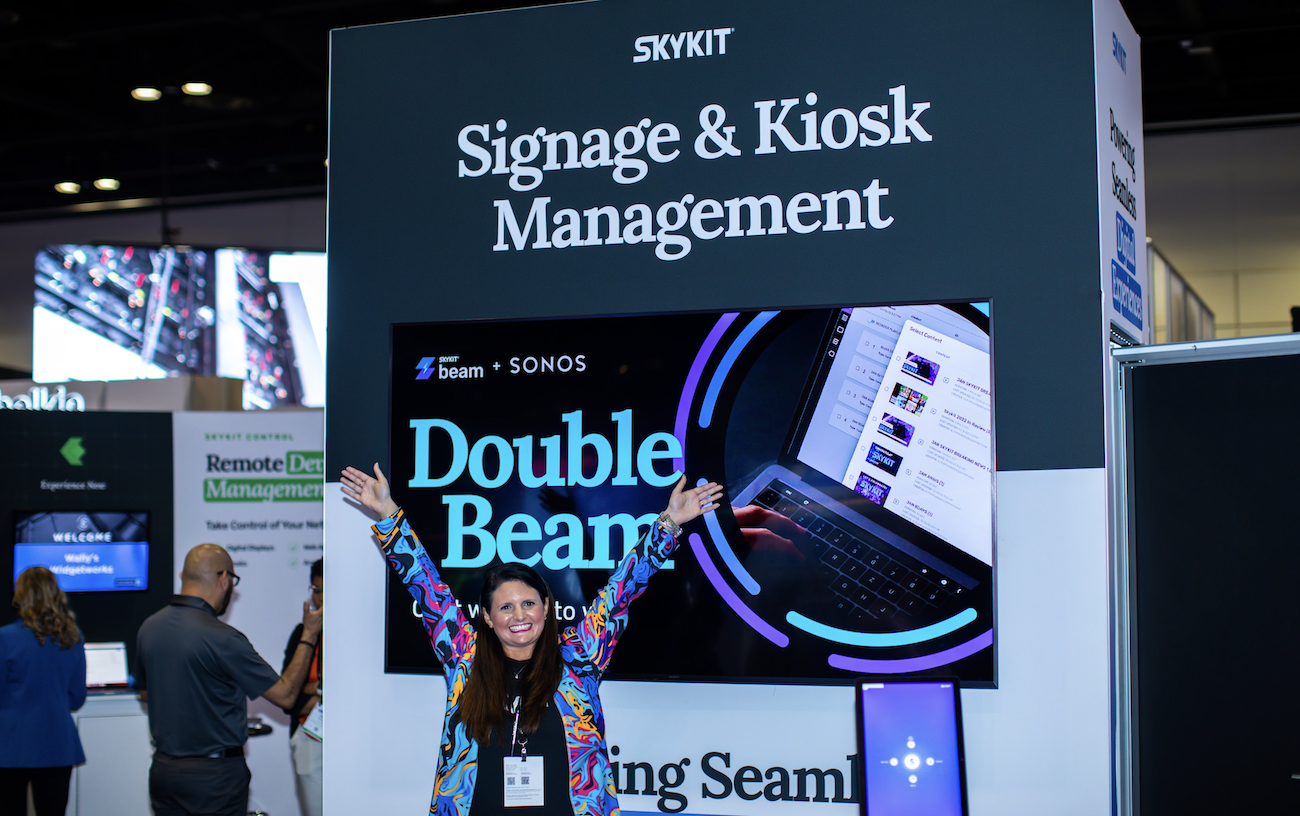Video has changed the world.
Since the very first motion picture shot in the summer of 1878, moving pictures have given us reason to stop and stare.
Videos tell stories. They touch our emotions. Very often, they change our lives.
You remember the movie Forrest Gump, right? The story of the mentally challenged man who accidentally showed up during many historic moments, teaching us life lessons on his road to becoming a millionaire?
Forrest Gump is just one example of how video engages, attracts, and shifts the human condition.
But enough about history. Let’s talk about today, and how video integrated into your digital signage campaign can change the way you do business.
For starters, having the software and hardware to create appealing content is only the beginning. If you’re not using video in pieces of what you create, that’s like owing a motorcycle you never ride. You have the machine to get you places; you just don’t do anything with it.
We want you to ride.
Whether you’re using digital signage to educate your workforce or create killer content for potential customers, video can be the one ingredient that changes everything.
Having said that, let’s dig into why video is vital in your digital signage campaign, shall we?
1. Video for Digital Signage Just Looks Better
Let’s face it. If given the option, would you choose a series of still photos and words in a binder to learn a concept, or a nice, pretty, streamlined video?
You would choose the video.
And you would choose it because it’s fast, colorful, and can tell a story much better.
Without question, video is the future of content marketing.
In a 2013 marketing study released by ReelSEO, the company determined that 93% of marketers are using video in their campaigns. And they’re using it because it’s what is being watched, shared (online), and talked about the most.
This stat alone tells us that a compelling video strategy is the pathway to a powerhouse marketing campaign.
2. Videos Trigger Emotions
When consumers buy, they buy for one of two reasons:
a. They need to avoid pain.
b. They need to gain pleasure.
If you’re using video to elicit an emotion, it’s going to go one of these two ways, every time.
Your video will either empower the consumer to take back her life (to avoid further pain), or to conquer the world in a new Mercedes (to gain pleasure).
Consumers will buy products or services based on emotional needs or wants, and then justify their purchase logically. That’s why it’s crucial to trigger their emotions based on their needs and wants.
If you don’t trigger a need, you don’t move the viewer.
According to an Invodo study, 52% of shoppers confess that watching product videos makes them more confident in making a purchase.
Think about that percentage for a moment:
If you replaced your still images with videos that elicit pleasure or pain and ultimately trigger emotion, things could change drastically for your business.
Why do you think so many non-profit organizations use children or animals in their video campaigns? It’s because they understand that including powerful, emotional video with puppies and children can and will tug at your heartstrings.
Once you feel the tug, you’re bound to open your purse strings.
3. Videos Solve a Problem
The number of people that search YouTube regularly to find an answer to solve a problem is staggering.
How staggering? It’s upwards of 4 billion.
Before even considering Google as a search option, problem solvers will head to YouTube to find a how-to video first.
From ‘How to Market With Digital Signage’ to ‘How to Pick the Right Puppy,’ the answers always come in video form.
Corporations and businesses are clinging to this knowledge, using videos that solve problems and are entertaining to watch.
These videos range from safety procedures to sales strategies. Corporations understand that a training video that is engaging and entertaining will be more memorable than a handbook or talking head.
Many corporations feel videos are an efficient learning resource, and are well worth the investment.
Video Scribing is one method businesses are using to teach or share information in a visually interesting way. Video scribing is basically a whiteboard drawing captured at high speed, and then narrated over the top with an audio track.
No matter which method you use, video is key to solving problems quickly and colorfully.
4. Videos Make Businesses Money
If you aren’t using video to market your goods, you’re missing out. At least that’s what marketers that use video regularly say
Up to four times as many customers said they would rather watch a video about a product than read about it.
The Lego store in downtown Disney in Orlando gets that.
The retailer uses a digital screen to show customers (which are most often the little ones) what their lego kit will look like when it’s fully assembled. This gets the kids excited, which in turn gets the parents excited.
Large stadiums and arenas see thousands of people move through the turnstile regularly. For advertisers, that’s a huge opportunity to show the world who they are and what they can do.
These stadiums use digital signage to live stream video of ongoing games. This allows fans the ability to still watch the action from the bathroom, corridor, or concession stand.
Marketing content is displayed along the borders of the video and is rotated regularly, giving viewers plenty of opportunity to experience repetition of any given brand.
5. Videos Make Cities Money
On the other side of the globe in the UK, one city found a way to bring in more revenue to improve the city using digital signage.
Newcastle in England installed a large digital advertising board at a popular intersection. It’s similar to one that was installed over Newcastle’s Central Motorway.
Interested advertisers can put in a bid to stream video on either sign. Revenue goes back into citywide public services.
It’s a grand idea that has other cities wanting to do the same.
Using the idea of advertising to bring a city more revenue has been on the mind of lawmakers in the city of Philadelphia for some time now. Dubbed the Digital District, the concept to install various digital signs in a concentrated area of the city to generate revenue has met some opposition.
Two years after it’s initial proposal, the concept is still being considered. If brought to fruition, the signs would not only communicate advertising, but would share news and service announcements, too.
6. Videos Engage
Based on our examples so far, we know that video, when done right, can engage the viewer. But it has to be done quickly.
In a 2013 report, The National Center for Biotechnology Information recorded that the average attention span of a viewer was 9 seconds: one second less than the attention span of a goldfish.
In a word, your video has to bait the fish. Fast.
And not because viewers have somewhere to be, but because they want to know how long they think it will take them to get the gist of it. That’s really what engagement is; the length of time it takes for a viewer to decide if what they’re watching is something they will understand.
If a viewer doesn’t believe he or she will understand or find an answer sooner than later, they’ll leave.
This is why Video Scribing is often used.
In scribing, the start of the video is an incomplete drawing. In order to see what the final image will look like, the viewer will need to stick around. Therefore, they will remain engaged until the artist is finished.
Conclusion
With all of the facts lined up and the statistics in place, it’s hard to argue that video for digital signage isn’t a major driving force in a successful marketing campaign.
With various ways to reach your intended audience, determining which is right for you is based on what your viewer needs.
Is the video created to solve a problem?
Will it trigger pain or pleasure?
What can you say and how can you say it in a way that entertains and engages?
Consider these questions before implementing a visual strategy. And remember that numbers don’t lie. Take a gander at the information Buzzplant.com collected in 2015 regarding online video marketing. Here are just a few:
– 75% of business executives watch work-related videos at least weekly.
– 54% of senior executives share work-related videos with colleagues at least weekly.
– 59% of senior executives agree that if both text and video are available on the same topic on the same page, they prefer to watch the video.
– 69% of marketing, sales and business professionals have used video marketing and another 31% are planning to.
– 81% of people feature their video on their brand website.
You get the picture. (No pun intended.)
All said, video is working. We live in a world where we are constantly being bombarded with information. Give your customer or viewer a reason to stay engaged with your information.
The more you show up, the more they show up.
In what ways have you seen effective video marketing in digital signage done well?



